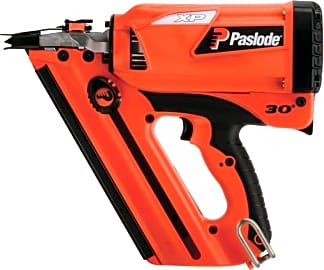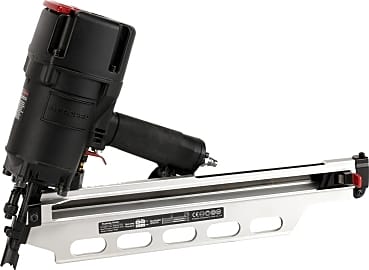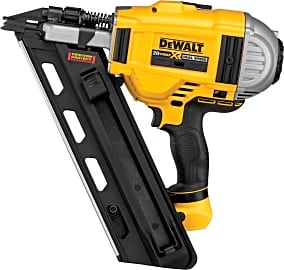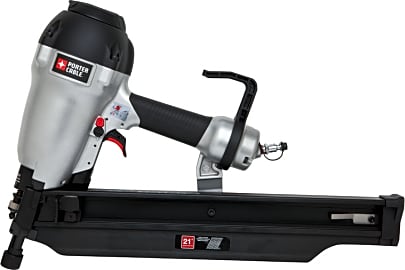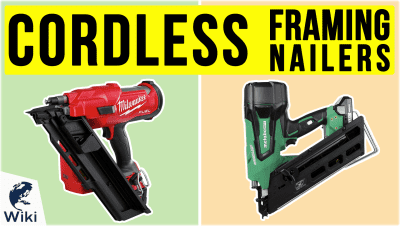The 10 Best Framing Nailers

This wiki has been updated 41 times since it was first published in April of 2015. Of all the styles of nail guns, framing nailers are designed to do the heaviest lifting, so to speak, joining boards and planks swiftly and securely. While they're not the most precise of tools, they will make quick work of roughing out any construction or remodeling project. Our selection includes a variety of models to suit your needs, all with significant driving power. When users buy our independently chosen editorial recommendations, we may earn commissions to help fund the Wiki.
Editor's Notes
June 30, 2019:
If you've ever worked on a challenging construction or DIY project, you know that using a humble hammer to set nails is not an option. These framing nailers can fire dozens of nails in minutes, and at no great energy expense to the user. While most of the tools featured here require an air compressor, there are also two cordless models to choose from: the DeWalt DCN692B and Paslode 905600. It's important to note that nail guns are inherently dangerous and must be used and stored with care.
The Estwing EFR2190 and Metabo NR90AES1 have been added to the list, the former because of its lightweight, yet durable design, and the latter for its intuitive mode-changing switch and easy disassembly process. The Senco 4H0101N and Hitachi NR90AES1 are no longer featured in this list due to quality and fulfillment concerns, respectively, and the Freeman PFR3490 has been promoted to the number one slot because of its dependability and popularity.
How To Choose The Right Framing Nailer
Beyond that, there are other features that you should consider, such as nail size, depth adjustment, and whether it comes with a carrying case.
If you do a lot of woodworking, then a good framing nailer is an essential addition to your tool chest. These handy machines can drastically cut down on the amount of time it takes to put together a frame, and after using one, you'll soon find it impossible to go back to a regular hammer.
The first thing you need to know is that there are two fundamental types of framing nailers. The pneumatic kind requires an air compressor to fire the nails into the frame, while the cordless variety uses a replaceable air canister instead.
Pneumatic nailers tend to be more powerful and don't require you to purchase canister refills (you would have to buy an air compressor if you don't already have one). Cordless nailers, on the other hand, don't tether you to an air hose, giving you more mobility on the job site. Either option works, so whichever you choose is largely a matter of personal preference.
Trigger type varies, as well. Some have what's known as a bump trigger, in which you can hold down the trigger and shoot out a nail every time the plate bumps the wood. This is great for working quickly, but can lead to sloppiness. Single-fire triggers, on the other hand, require you to pull the trigger every time you want to send a nail home. Single-fire is probably better for beginners, but bump triggers are way better for giving the impression that you know what you're doing.
When choosing between options, there are a few things you should consider in order to be sure that you get a tool that will reduce your frustration, rather than add to it. The first is the size of the nail magazine. Having to constantly stop working to refill your nails is a pain, so larger is better in this instance. However, read carefully to see if it's prone to jamming. Having the biggest capacity in the world isn't helpful if you're constantly having to stop and clear out stuck nails.
Beyond that, there are other features that you should consider, such as nail size, depth adjustment, and whether it comes with a carrying case. There isn't necessarily a right or wrong answer with these features — it's all about what works best for your particular needs.
Tips For Getting The Most Out Of Your Framing Nailer
If you've never used one of these tools before, they can be a little intimidating at first. Once you get the hang of it, however, you'll find that they're actually simple to use.
One of the advantages of the framing nailer is that you can use smaller nails, which allows you to work without leaving a large footprint.
One of the advantages of the framing nailer is that you can use smaller nails, which allows you to work without leaving a large footprint. This is great for assembling things like cabinets, as you can use the nailer to hold the wood in place before you shoot screws into it. This can drastically cut down on the time and frustration required for more intricate jobs.
Nailers also make it easier for the beginner to toenail wood. If you're not familiar with the term, toenailing is when you quickly anchor a stud by sending a nail through it at a 45° angle. Experienced carpenters can do this in a flash, but it's a skill that takes a while to learn — and a nailer can dramatically cut down on your learning curve.
These machines are fantastic for installing molding and baseboards as well. If you've been putting off doing this because it's such slow, tedious work, you'll be amazed at how quickly it goes by with a framing nailer. Simply use another block of wood to hold the trim in place, shoot a couple nails in, and you're done!
Beware, however: while getting these jobs done quickly will make you look like a hero, it also dramatically increases the odds that you'll be given even more chores to do.
How To Use Your Framing Nailer Safely
Just because nailers are easy to use doesn't mean that you can't hurt yourself with one if you're not careful. These are still dangerous machines, and every year 37,000 people are sent to the hospital because of nail gun mishaps. There's a reason that many of the safety features on a nailer resemble those found on handguns, so treat them with the same level of respect.
There's a reason that many of the safety features on a nailer resemble those found on handguns, so treat them with the same level of respect.
You've heard this a million times, but safety goggles are a must-have when working with a nailer. I know, you're not dumb enough to shoot a nail into your eye, but when those suckers fly out of the gun, they can spray splinters everywhere. Getting a sliver of wood in your cornea is not a fun way to spend your weekend.
Also, don't take apart any of the safety mechanisms on your nail gun. Many people do this thinking it will increase the speed with which they can work, but those gains are minimal at best, and your efficiency will be drastically reduced if you have to spend the afternoon in the ER.
Just like with a regular gun, look where you're shooting before you fire. Don't get caught up in a rhythm and fire nails blindly without first making sure that someone's hand or foot isn't in the way. Also, if you're new to toenailing, then steel-toed boots are probably a good investment, as they can help prevent you from putting some unwanted steel into your toes.
Don't be afraid of or intimidated by your nailer, but don't lose respect for it, either. When used properly, it's a safe and excellent tool. When used carelessly, however, it will certainly ruin your day.





